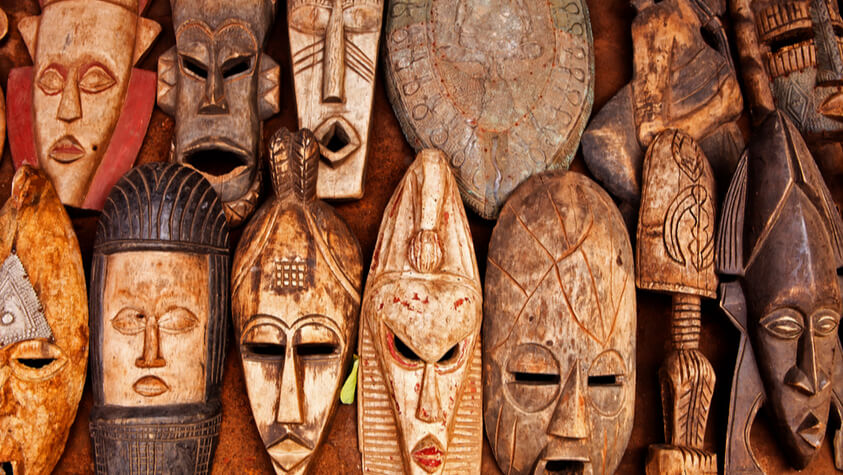By TACP Staff on July 07,2021

The creator of African art is someone who has either experienced and/or studied the culture from which it is derived. Traditionalists create wood carvings and sculptures, utilizing classical designs. Those seeking a modern approach work in styles such as expressionism, cubism, and surrealism. And of course, there are those who pursue a strictly personal approach. The mediums and methods of African art include silk screening, brass casting utilizing the ancient wax process and creating welded sculptures from various metals. This field is perfect for artists passionate about expressing the African culture in an unlimited number of ways.
In the most basic sense, African art is a type of art that originated and is influenced by the number of diverse cultures in Africa.
Just as many historians believe that Africa was the birthplace of all mankind, some art experts believe that African art was the beginning of all art. Whether this is true or not, like most other types of art, African art has roots in ancient times. Some rock carvings that have been found, for instance, are estimated to be thousands of years old.
The earliest pieces of African art, however, were generally small and useful, unlike traditional art object that most people would think of when they hear the word art. For instance, these early artists did not create traditional paintings on canvas, nor did they create such items as massive stone or metal sculptures. Instead, African art was generally small and portable, as well as useful. Paintings tended to be on everyday objects, like dishes or clothing, for instance, and carvings or sculptures were generally used to adorn everyday objects like furniture, utensils, and spiritual items.
The nomadic characteristics of Africa’s – and possibly the earth’s – first people were believed play a part in shaping these types of art. Because these people were always on the move, it would have been difficult and cumbersome to transport several large works of art. Out of sheer necessity, this culture created portable and useful pieces of art instead in order to transport them easily.
Throughout the years, the main characteristics and styles of most types of African art have evolved with the times only slightly. Today’s modern African art, for instance, may be created with more advanced materials and equipment. The main characteristics of this type of art, however, have remained the same.
The subjects in most African art forms are usually human figures, or human-like figures. In African art, these subjects typically take the form of real humans – living or dead – as well as deities, animals, and emotions.
For the most part, however, figures in African art are not usually perceived as realistic, nor are they meant to be. Instead, these figures take on a more abstract form. The majority of African art pieces are more about symbolism than realism. Masks, for example, are very common types of African art. These are usually used during religious ceremonies only, but some collectors also display them prominently as well.
Youthfulness and vitality are also common characteristics of African art. These two characteristics are often associated with strength and fertility, which were considered to be extremely important in ancient times.
Flat 2D art forms are far less common in African art than they are in other types of art. Instead, African artists generally tend to concentrate on 3D art forms, like sculptures. Most African artists and painters will also usually try to incorporate some 3D effects into their flat paintings as well.
In order to make his passion a career, an artist should be very talented. To succeed in an African art career, an artist should also be able to mesh his own style with the predominant characteristics of African art.
An artist technically doesn’t need any sort of formal training to pursue an African art career, but a degree in fine arts or art history can be helpful.
Degrees in fine art allow a student to fine tune their existing skills. It also allows students interested in this type of art to focus on incorporating African art into their own style of artwork. Art history degrees are also very helpful for those interested in pursuing an African art careers. Students who study art history will often have the opportunity to focus on or specialize in a certain type of art, including African art.
The Bureau of Labor Statistics does not have any information specifically regarding an African art career, but these types of artists typically fall under the broad category of fine artists. In 2010, the average annual wage for these types of artists was $53,080. African artists interested in becoming curators, however, will usually be able to command a higher wage. Competition for this type of employment is generally very fierce, and the average salary for these positions will usually reflect this. For example, in 2008 museum curators had an average annual salary of $90,205.
Art is an extremely competitive industry, and generally, only the talented and determined individuals will have a successful African art career. Like most artists, an African artist can choose to work as a freelancer, creating original works of art. Talented artists may even have their work displayed in an art gallery or museum, and they might also be able to find interested art collectors to buy their work. African artists with impressive portfolios might also be commissioned to create sculptures, murals, and other pieces of work. Museum work is another possibility for individuals interested in an African art career. In order to work in a museum, an artist will usually need to have a degree in fine arts or art history. African art museum curators will usually need to have a Master’s degree in these areas, and many museums require a course in museum studies as well.
Consider these related careers in Craft and Fine Art.

The Art Career Project is a trusted resource for emerging and professional artists.